CO2 Corrosion Behavior of X70 Steel under Typical Gas–Liquid Intermittent Flow
Abstract
1. Introduction
2. Experimental
2.1. Material
2.2. Solution
2.3. Experimental Setup
2.4. Experimental Procedure and Corrosion Tests
3. Results and Discussion
3.1. Potentiodynamic Polarization Test
3.2. EIS Tests
3.3. Corrosion Morphology Observation
4. Discussion
4.1. CO2 Corrosion Mechanism
4.2. Effect of Flow Velocity
4.3. Effect of Gas–Liquid Ratio
5. Conclusions
- (1)
- The flow velocity has a more profound effect on the corrosion rate than the gas–liquid ratio. Overall, the corrosion rate of X70 pipeline steel increases with the flow velocity, with the highest gas–liquid ratio (i.e., 5:1) studied in this work as an exception.
- (2)
- The effect of gas–liquid ratio on the corrosion rate of X70 pipeline steel depends on the flow velocity. At a low flow velocity, the corrosion rate always increases with the gas–liquid ratio, as both the anodic and cathodic reaction rates are enhanced at higher gas–liquid ratios. At a high flow velocity, the corrosion rate appears to slightly decrease with the gas–liquid ratio on the whole, and the smallest corrosion rate is seen with the gas–liquid ratio of 1:1.
- (3)
- An intermittent flow with a high gas–liquid ratio promotes localized corrosion, regardless of the flow velocity.
- (4)
- The intermittent flow with high gas–liquid ratios promotes the non-uniform formation of FeCO3 scale on the steel surface. The Galvanic series, once formed between the surface with compact FeCO3 scale and the bare steel substrate, stimulates the anodic reaction rate on the steel surface and leads to localized corrosion.
Author Contributions
Funding
Data Availability Statement
Conflicts of Interest
References
- Ge, P.L.; Gao, D.L.; Liu, Q.S.; Xu, Y.Y.; Xiao, W.W.; Jia, X.D. Failure analysis on corrosion perforation of sulfur-containing wet gas pipeline in Tahe Oilfield. Pet. Tubul. Goods Instrum. 2021, 7, 79–83. (In Chinese) [Google Scholar]
- Dong, Z.Q.; Xia, Y.; Zhang, J.X. Corrosion perforation failure analysis of a natural gas pipeline in service. Pet. Tubul. Goods Instrum. 2019, 5, 75–78. (In Chinese) [Google Scholar]
- Luo, P.; Zhang, Y.L.; Cai, P.P.; Guo, Z.H.; Chen, H.Y.; Chen, W.B. Analysis and countermeasures of natural gas transmission pipeline internal corrosion accidents. Total Corros. Control 2010, 24, 16–21. (In Chinese) [Google Scholar]
- Zhang, H.Q.; Sarica, C. Low liquid loading gas/liquid pipe flow. J. Nat. Gas Sci. Eng. 2011, 3, 413–422. [Google Scholar] [CrossRef]
- Guan, X.R.; Jin, Y.H.; Wang, J.; Zhang, D.L.; Li, H. Progress in investigating gas-liquid flow and CO2 corrosion in gas transmission pipelines with low liquid loading. Chem. Mach. 2017, 44, 245–251. (In Chinese) [Google Scholar]
- Wang, R.; Lee, B.A.; Lee, J.S.; Kim, K.Y.; Kim, S. Analytical estimation of liquid film thickness in two-phase annular flow using electrical resistance measurement. Appl. Math. Model 2012, 36, 2833–2840. [Google Scholar] [CrossRef]
- Li, J.; Wang, S.; Chen, H.; Xu, H. Numerical simulation of slug formation characteristics of the liquid loading in the gas-liquid multiphase pipeline in rolling terrain. Oil-Gas Field Surf. Eng. 2017, 36, 12–16. (In Chinese) [Google Scholar]
- Liu, X.; Li, Y.; Li, S.; Yuan, Z. Liquid holdup distribution laws and critical inclination angle model of undulating wet gas pipelines. Transp. Storage 2017, 36, 177–184. (In Chinese) [Google Scholar]
- Cui, M.W. Study on CO2 Internal Corrosion and Residual Strength of Multiphase Offshore Pipeline. Ph.D. Thesis, China University of Petroleum (East China), Qingdao, China, 2014. (In Chinese). [Google Scholar]
- Jepson, W.P.; Kang, C.; Wilkens, R. The Effect of Slug Frequency on Corrosion in High Pressure, Inclined Pipelines. In Proceedings of Corrosion 96, Houston, TX, USA, 26 August 1996. [Google Scholar]
- Zheng, D.H.; Che, D.E.; He, L.; Lu, M.X. Effect of slug flow on CO2 corrosion of pipeline in oil and gas industry. Corros. Prot. 2007, 28, 77–81. (In Chinese) [Google Scholar]
- Villarreal, J.; Laverde, D.; Fuentes, C. Carbon-steel corrosion in multiphase slug flow and CO2. Corros. Sci. 2006, 48, 2363–2379. [Google Scholar] [CrossRef]
- Zheng, D.; Che, D.; Liu, Y. Experimental investigation on gas–liquid two-phase slug flow enhanced carbon dioxide corrosion in vertical upward pipeline. Corros. Sci. 2008, 50, 3005–3020. [Google Scholar] [CrossRef]
- Feng, Z.; Cui, M. Influence of Slug Flow on Local Corrosion of Pipelines. Surf. Rev. Lett. 2019, 27, 1950147. [Google Scholar] [CrossRef]
- Li, J.H.; Wang, D.; Xie, F. Failure analysis of CO2 corrosion of natural gas pipeline under flowing conditions. Eng. Fail. Anal. 2022, 137, 106265. [Google Scholar] [CrossRef]
- Wang, W.; Sun, Y.; Wang, B.; Dong, M.; Chen, Y. CFD-Based Erosion and Corrosion Modeling of a Pipeline with CO2-Containing Gas–Water Two-Phase Flow. Energies 2022, 15, 1694. [Google Scholar] [CrossRef]
- SP0110-2018-SG; Wet Gas Internal Corrosion Direct Assessment Methodology for Pipelines. NACE International: Houston, TX, USA, 2018.
- Liu, E.; Li, D.; Zhao, W.; Peng, S.; Chen, Q. Correlation analysis of pipeline corrosion and liquid accumulation in gas gathering station based on computational fluid dynamics. J. Nat. Gas Sci. Eng. 2022, 102, 104654. [Google Scholar] [CrossRef]
- Li, Q.; Zhang, Y.Y.; Liu, G.; Zhu, T.Y.; Tang, X.; Li, Y. CO2 corrosion mechanism of pure Fe under action of uniform water film. J. China Univ. Pet. 2020, 44, 155–161. (In Chinese) [Google Scholar]
- Qian, S.; Cheng, Y.F. Corrosion of X52 steel under thin layers of water condensate in wet gas pipelines. J. Nat. Gas Sci. Eng. 2019, 68, 102921. [Google Scholar] [CrossRef]
- Qian, S.; Cheng, Y.F. Corrosion of steel in a CO2-containing solution droplet generated in wet gas pipelines studied by scanning Kelvin probe. J. Pipeline Sci. Eng. 2022, 2, 71–77. [Google Scholar] [CrossRef]
- Lu, Y.; Wang, R.; Han, Q.; Yu, X.; Yu, Z. Experimental investigation on the corrosion and corrosion fatigue behavior of butt weld with G20Mn5QT cast steel and Q355D steel under dry–wet cycle. Eng. Fail. Anal. 2022, 134, 105977. [Google Scholar] [CrossRef]
- Gong, K.; Wu, M.; Liu, G. Comparative study on corrosion behaviour of rusted X100 steel in dry/wet cycle and immersion environments. Constr. Build. Mater. 2020, 235, 117440. [Google Scholar] [CrossRef]
- Zhao, J.L.; Tang, J.N.; Deng, Y.M.; Luo, J.X.; Zhu, K.J. A Rotary Dry-Wet Cycle Experimental Setup. China Patent 201,420,305,193.1, 31 December 2014. (In Chinese). [Google Scholar]
- Yang, Y. CO2 corrosion of offshore wet-gas flowlines under different surface wetting conditions. Ph.D. Thesis, Southwest Petroleum University, Chengdu, China, 15 June 2019. (In Chinese). [Google Scholar]
- Mansoori, H.; Mirzaee, R.; Esmaeilzadeh, F.; Vojood, A.; Dowrani, A.S. Pitting corrosion failure analysis of a wet gas pipeline. Eng. Fail. Anal. 2017, 82, 16–25. [Google Scholar] [CrossRef]
- Paolinelli, L.D.; Nesic, S. Calculation of mass transfer coefficients for corrosion prediction in two-phase gas-liquid pipe flow. Int. J. Heat Mass Tran. 2021, 165, 120689. [Google Scholar] [CrossRef]
- ASTM G1-03; Standard Practice for Preparing, Cleaning, and Evaluating Corrosion Test Specimens. ASTM International: West Conshohocken, PA, USA, 2011.
- Yang, G.; Song, W.; Zhu, Z.; Ma, Y.; Hao, Y. Effect of liquid flow velocity on corrosion behavior of 20# steel at initial stage under gas-liquid two-phase plug flow condition. Anti-Corrs. Method M. 2020, 67, 415–425. [Google Scholar]
- Barker, R.; Burkle, D.; Charpentier, T.; Thompson, H.; Neville, A. A review of iron carbonate (FeCO3) formation in the oil and gas industry. Corros. Sci. 2018, 142, 312–341. [Google Scholar] [CrossRef]
- Sun, Y.; Nesic, S. A parametric study and modeling on localized CO2 corrosion in horizontal wet gas flow. In Proceedings of Corrosion 2004, New Orleans, LA, USA, 28 March–1 April 2004. [Google Scholar]
- Islam, M.M.; Pojtanabuntoeng, T.; Gubner, R. Corrosion of carbon steel under condensing water and monoethylene glycol. Corros. Sci. 2018, 143, 10–22. [Google Scholar] [CrossRef]
- Singer, M. Study of the localized nature of top of the line corrosion in sweet environment. Corros. Eng. Sect. 2017, 73, 1030–1055. [Google Scholar] [CrossRef]
- Li, Q.; Cheng, Y.F. Modeling of corrosion of steel tubing in CO2 storage. Greenh. Gases 2016, 6, 797–811. [Google Scholar] [CrossRef]
- Sun, W.; Nešić, S. Kinetics of Corrosion Layer Formation: Part 1—Iron Carbonate Layers in Carbon Dioxide Corrosion. Corros. Eng. Sect. 2008, 64, 334–346. [Google Scholar] [CrossRef]
- Tan, Z.; Yang, L.; Zhang, D.; Wang, Z.; Cheng, F.; Zhang, M.; Jin, Y. Development mechanism of internal local corrosion of X80 pipeline steel. J. Mate. Sci. Technol. 2020, 49, 186–201. [Google Scholar] [CrossRef]
- Matamoros-Veloza, A.; Barker, R.; Vargas, S.; Neville, A. Mechanistic insights of dissolution and mechanical breakdown of FeCO3 corrosion films. ACS Appl. Mater. Interfaces 2021, 13, 5741–5751. [Google Scholar] [CrossRef]
- Han, J. Galvanic Mechanism of Localized Corrosion for Mild Steel in Carbon Dioxide. Ph.D. Thesis, Ohio University, Athens, OH, USA, 2009. [Google Scholar]
- Li, W.; Pots, B.F.M.; Brown, B.; Kee, K.E.; Nesic, S. A direct measurement of wall shear stress in multiphase flow—Is it an important parameter in CO2 corrosion of carbon steel pipelines? Corros. Sci. 2016, 110, 35–45. [Google Scholar] [CrossRef]
- Al-Moubaraki, A.H.; Obot, I.B. Top of the line corrosion: Causes, mechanisms, and mitigation using corrosion inhibitors. Arab. J. Chem. 2021, 14, 103116. [Google Scholar] [CrossRef]
- Islam, M.M.; Pojtanabuntoeng, T.; Gubner, R. Condensation corrosion of carbon steel at low to moderate surface temperature and iron carbonate precipitation kinetics. Corros. Sci. 2016, 111, 139–150. [Google Scholar] [CrossRef]
- Sun, J.B.; Zhang, G.A.; Liu, W.; Lu, M.X. The formation mechanism of corrosion scale and electrochemical characteristic of low alloy steel in carbon dioxide-saturated solution. Corros. Sci. 2012, 57, 131–138. [Google Scholar] [CrossRef]

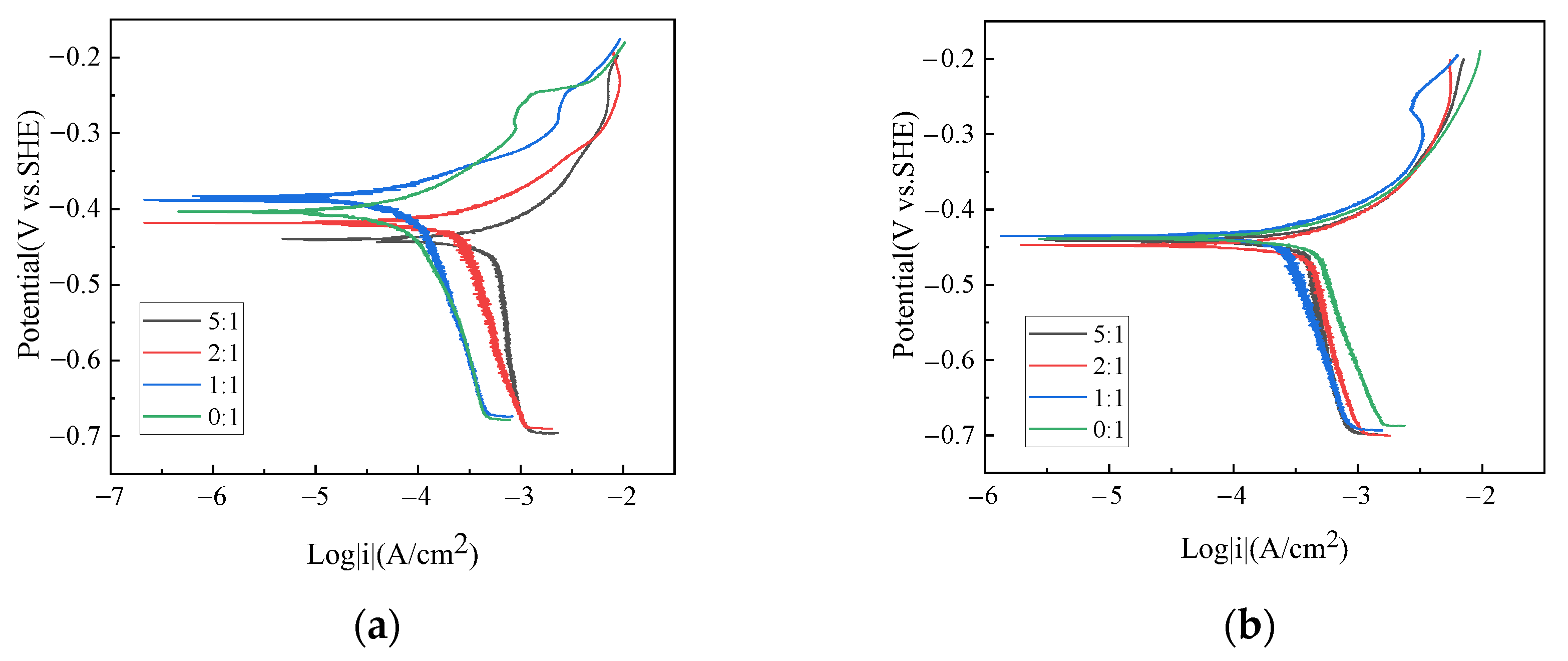
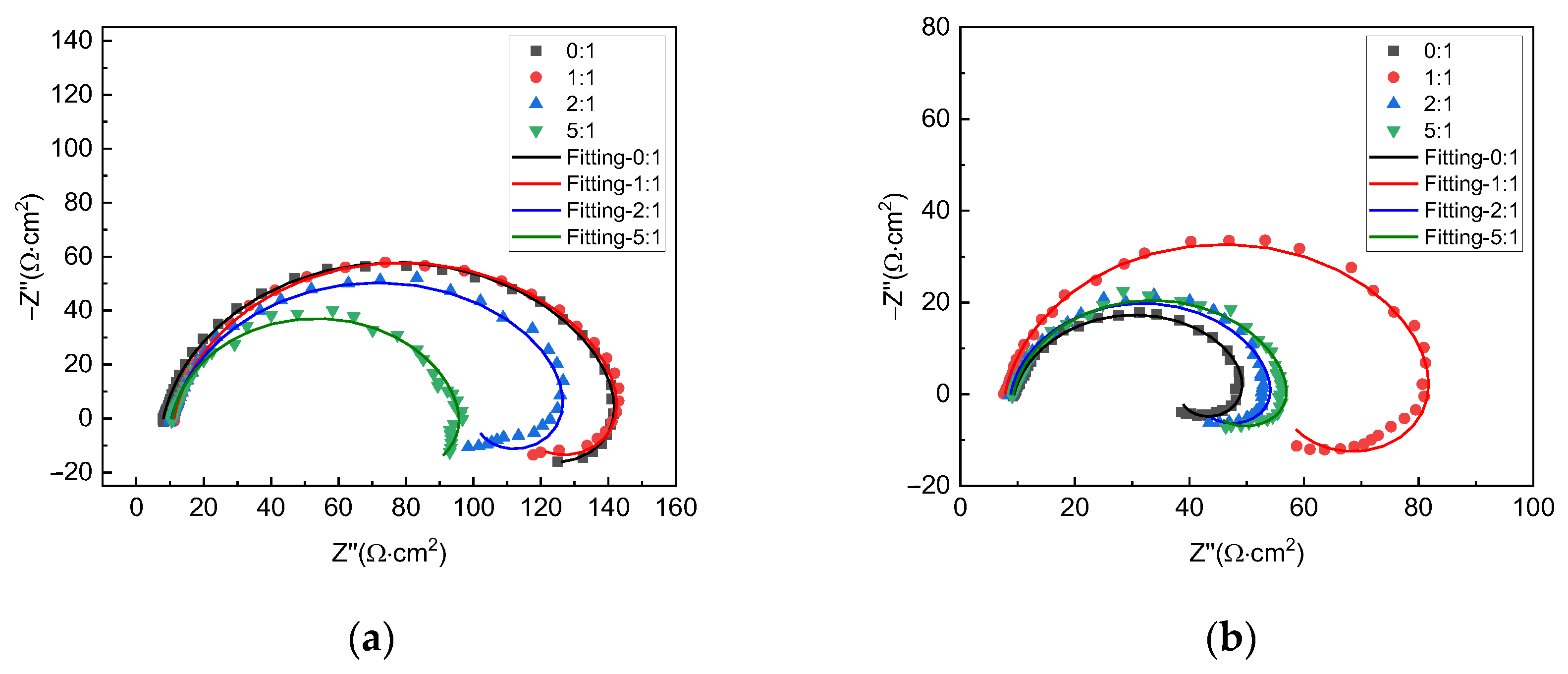

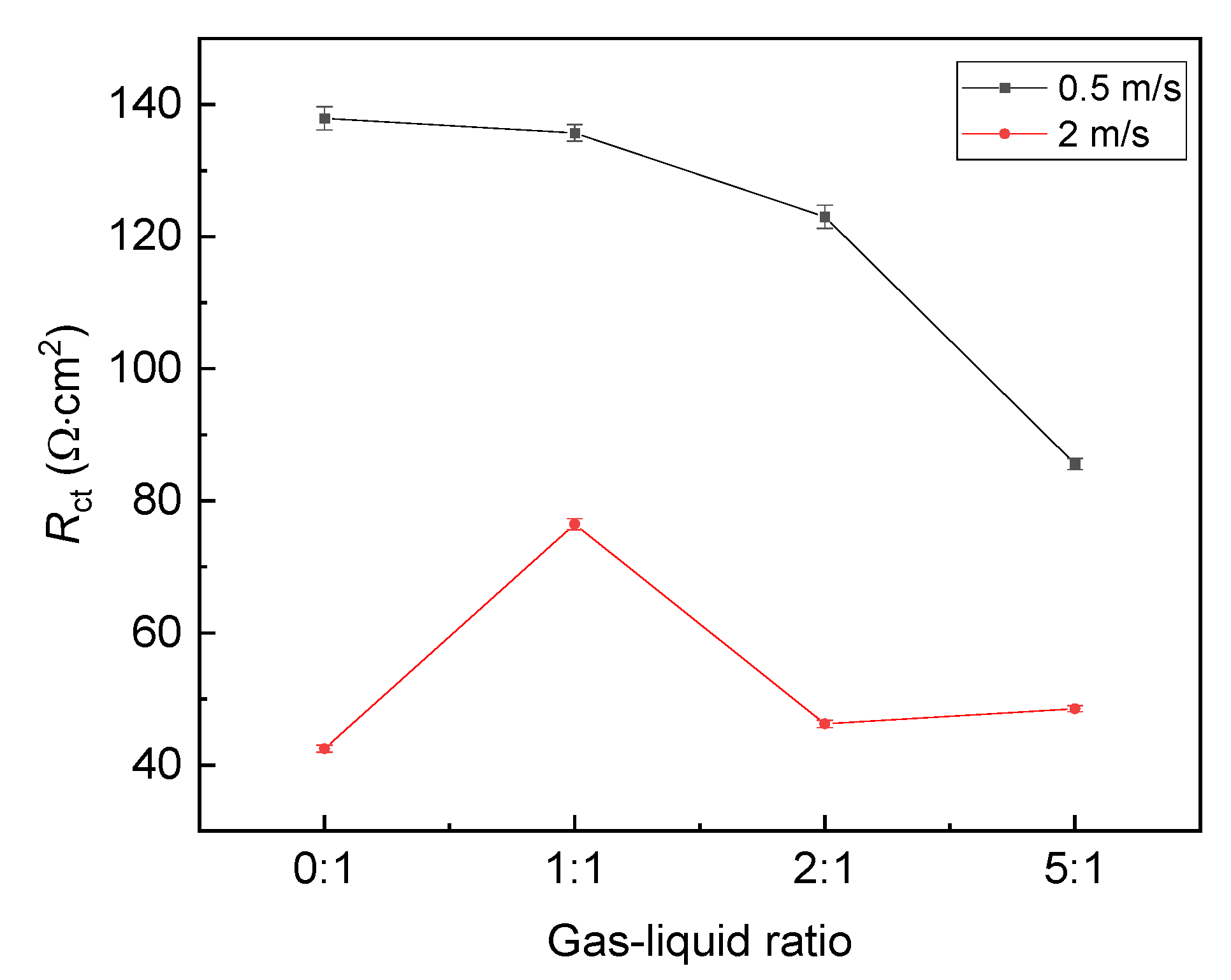

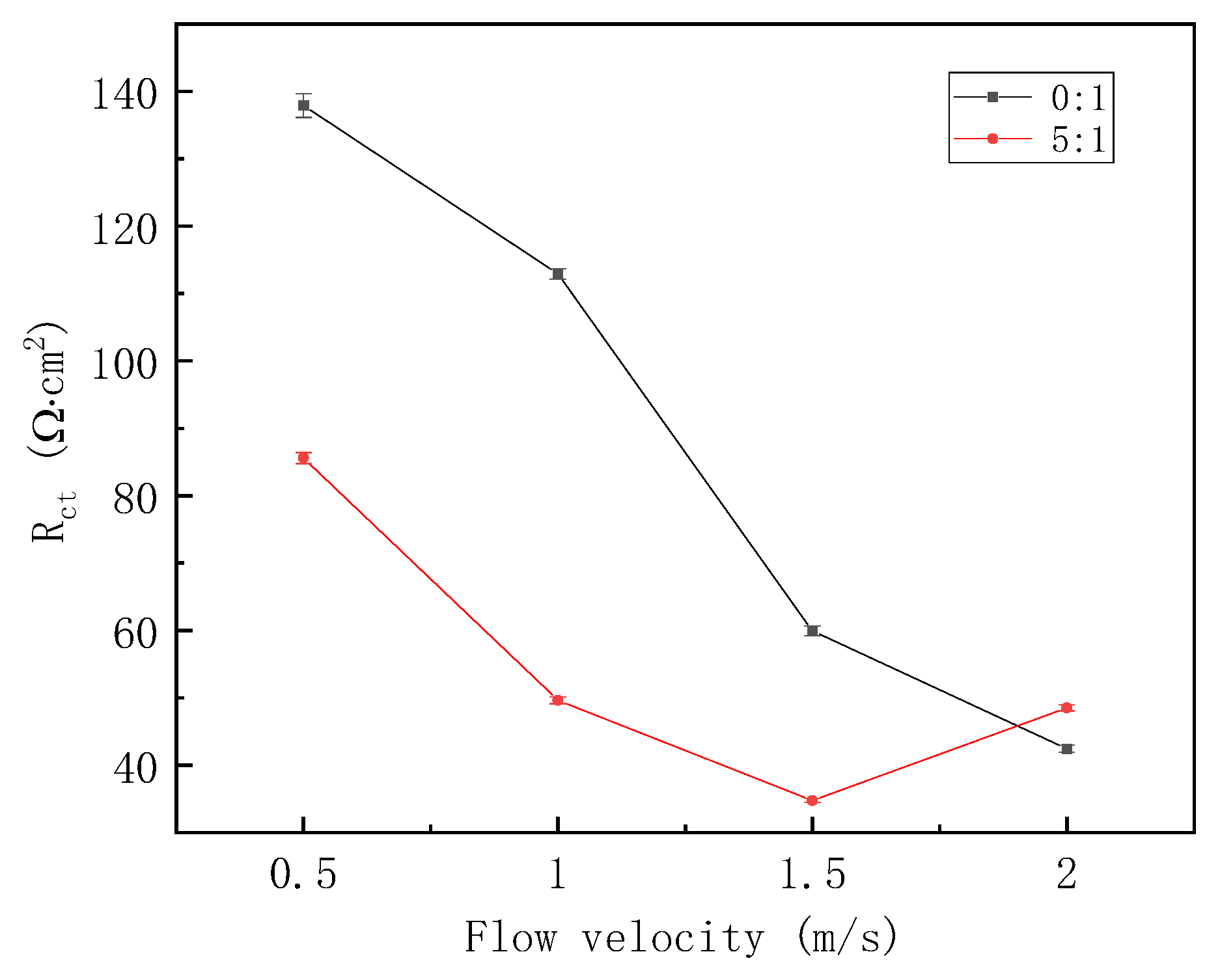

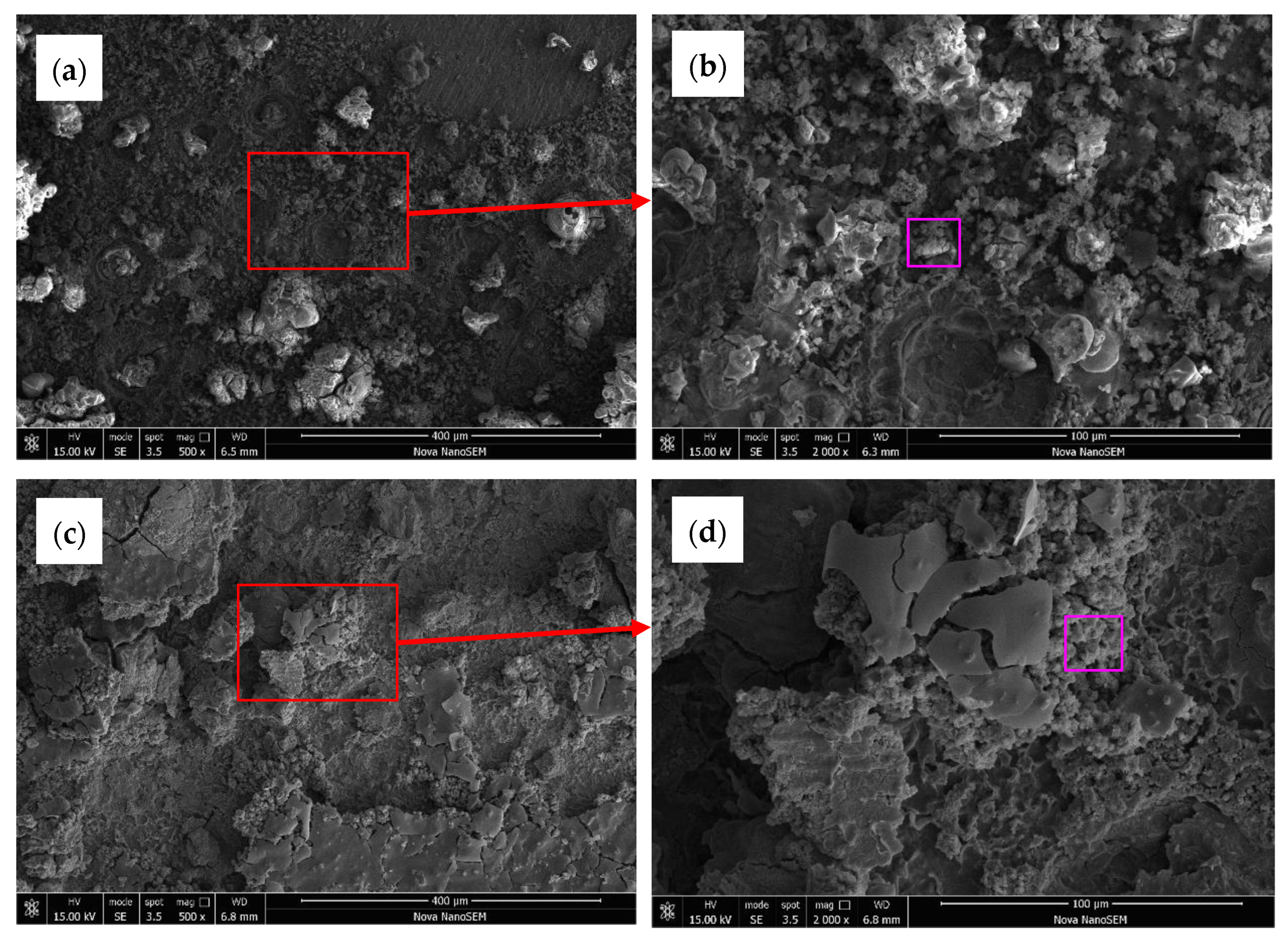
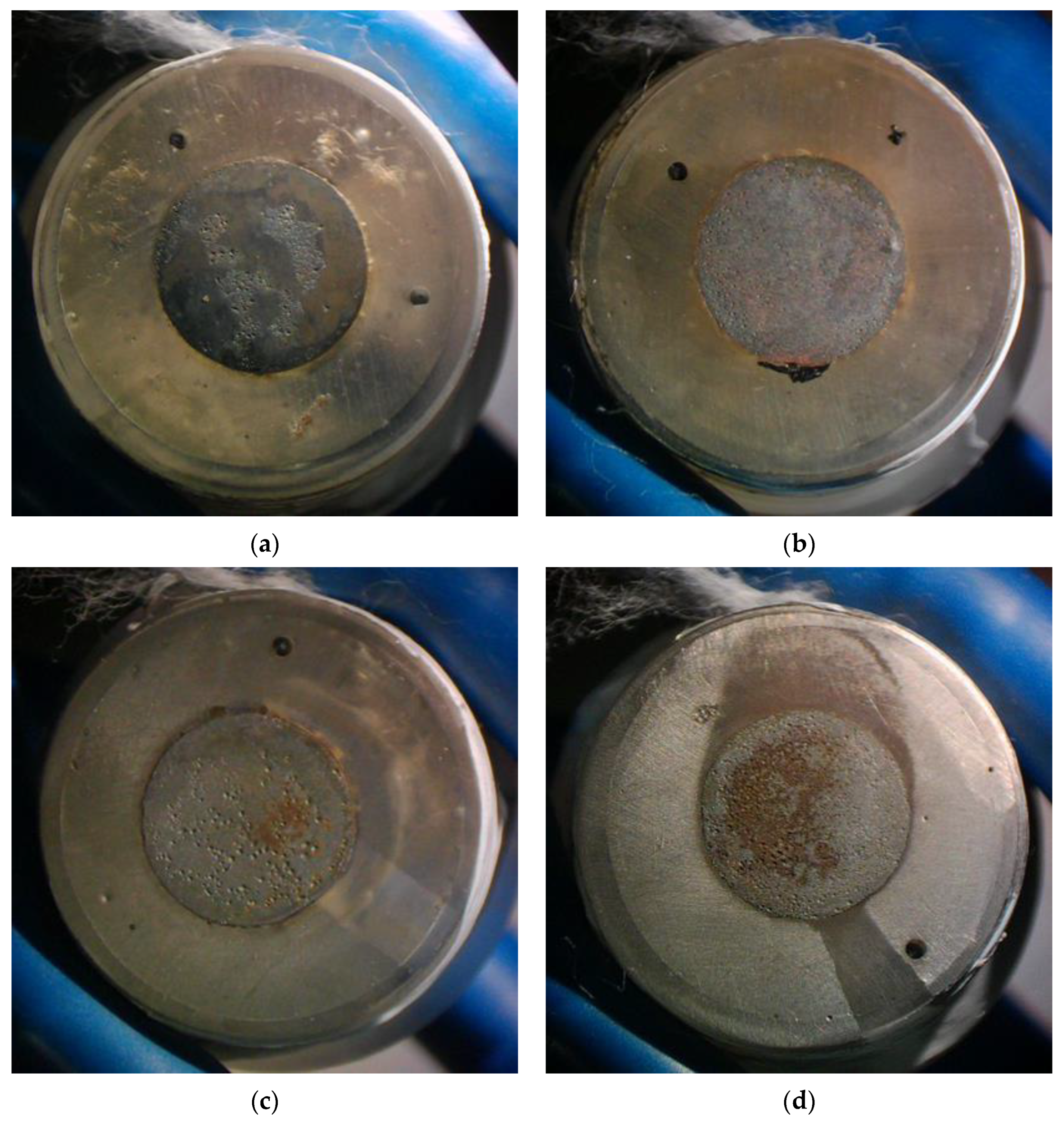
| Element | Content |
|---|---|
| C | 0.058 |
| Si | 0.425 |
| Mn | 1.418 |
| Nb | 0.049 |
| Ti | 0.009 |
| Mo | 0.146 |
| Cr | 0.146 |
| Ni | 0.038 |
| P | 0.011 |
| S | 0.002 |
| Liquid Flow Velocity | Gas–Liquid Ratio | Atomic Number % | |||
|---|---|---|---|---|---|
| C | O | Fe | Na + Cl | ||
| 0.5 m/s | 5:1 | 7.11 | 25.5 | 67.39 | Balance |
| 0:1 | 22.17 | 37.09 | 37.91 | ||
| 2 m/s | 5:1 | 14.86 | 52.31 | 29.88 | |
| 0:1 | 29.95 | 31.37 | 36.12 | ||
| Rct | |
|---|---|
| Flow velocity | −0.779 |
| Gas-liquid ratio | −0.357 |
Disclaimer/Publisher’s Note: The statements, opinions and data contained in all publications are solely those of the individual author(s) and contributor(s) and not of MDPI and/or the editor(s). MDPI and/or the editor(s) disclaim responsibility for any injury to people or property resulting from any ideas, methods, instructions or products referred to in the content. |
© 2023 by the authors. Licensee MDPI, Basel, Switzerland. This article is an open access article distributed under the terms and conditions of the Creative Commons Attribution (CC BY) license (https://creativecommons.org/licenses/by/4.0/).
Share and Cite
Li, Q.; Jia, W.; Yang, K.; Dong, W.; Liu, B. CO2 Corrosion Behavior of X70 Steel under Typical Gas–Liquid Intermittent Flow. Metals 2023, 13, 1239. https://doi.org/10.3390/met13071239
Li Q, Jia W, Yang K, Dong W, Liu B. CO2 Corrosion Behavior of X70 Steel under Typical Gas–Liquid Intermittent Flow. Metals. 2023; 13(7):1239. https://doi.org/10.3390/met13071239
Chicago/Turabian StyleLi, Qiang, Wenguang Jia, Kaixiang Yang, Wenfeng Dong, and Bingcheng Liu. 2023. "CO2 Corrosion Behavior of X70 Steel under Typical Gas–Liquid Intermittent Flow" Metals 13, no. 7: 1239. https://doi.org/10.3390/met13071239
APA StyleLi, Q., Jia, W., Yang, K., Dong, W., & Liu, B. (2023). CO2 Corrosion Behavior of X70 Steel under Typical Gas–Liquid Intermittent Flow. Metals, 13(7), 1239. https://doi.org/10.3390/met13071239





